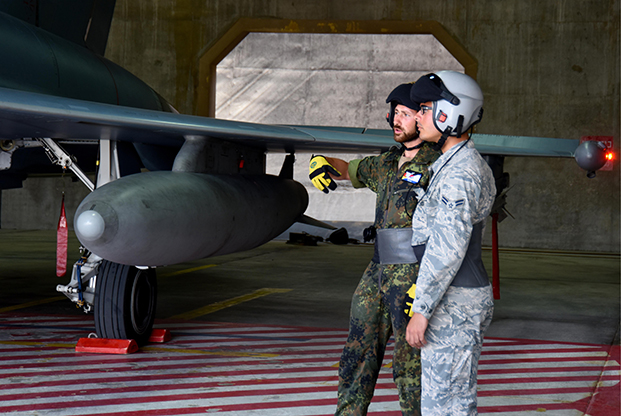
Then-A1C Cody Linholm (right, USAF) observes as German air force crew chiefs prepare a Eurofighter Typoon. SrA. Abby Finkel
BLUE FLAG IN ISRAEL
US airmen in November had the chance to work with airmen from seven other nations during Blue Flag 2017, a multinational exercise in, and hosted by, Israel.
The goal of the two-week exercise was “to simulate extreme combat scenarios and coalition fights as realistically as possible,” according to the Israeli Air Force.
Air forces from Poland, Italy, Greece, India, France, Germany, Israel, and the US participated.
Seven F-16Cs and about 200 airmen from the 31st Fighter Wing at Aviano AB, Italy, engaged in the live-fly exercise.
“Anytime we participate in a multinational exercise with many different partners and players, it builds our interoperability. It builds our ability to communicate, it builds our common understanding of culture, and it builds our common understanding of capabilities and tactics,” said Brig. Gen. Lance Landrun, commander of the 31st FW.
An Israeli pilot said the exercise was designed to find common ground for each air force, so missions were planned and executed together, and everyone shared how they would fight each mission.
Some of the sorties involved flying against the Israeli Air Force’s “Flying Dragon” aggressor squadron.
“This is a significant milestone in our relationship with the international air forces, some of which are arriving in Israel to train for the first time. This exercise will allow us to continue cooperating with these forces in the future as well,” said Lt. Col. Nadav, commander of the 133rd Squadron, the Israeli squadron that led the exercise.
During Blue Flag 2017, four USAF crew chiefs participated in a two-day exchange with air force crew chiefs from Germany. SrA. Cody Linholm, a crew chief with the 510th Aircraft Maintenance Unit (AMU), said he spent the first day of the exchange explaining his routine to his German counterpart.
“We showed them a step-by-step launch, the danger areas of the jet, where to go if hydrazine was to spill on the jet, and things like that,” he said. The next day, US airmen shadowed the Germans as they got Eurofighter Typhoons ready for a day of flying.
“It was a great experience to go over and actually work with the Germans. While the US Air Force does not fly or maintain the Eurofighter, it was still an opportunity to get out and experience something different, especially for our young maintainers,” said Capt. Jonathan Tolman, 510th AMU officer in charge.
_You can read this story in our print issue:
YEMEN QUESTIONS
Also in November, the House of Representatives passed a resolution (HR 599) stating that American assistance to the Saudi war against Iranian-backed Houthi rebels in Yemen is not covered by the authorizations for use of military force covering operations Inherent Resolve and Freedom’s Sentinel.
The resolution noted that the US “has participated in intelligence cooperation since 2015” with the Saudi-led coalition and has refueled coalition planes flying bombing missions in Yemen. It urged political solutions to the ongoing conflict, which intensified in early December after the death of the former Yemeni president, Ali Abdullah Saleh.
The resolution is nonbinding and does not attempt to end America’s participation in the war in Yemen. However, it acknowledged that Congress had not authorized participation and called for increased efforts to prevent civilian casualties and increase access to humanitarian assistance. At least 10,000 Yemenis have been killed since the war began in 2015, according to the resolution, and the World Food Program warned the country was on the brink of “full-scale famine” in April 2017, even before a Saudi blockade in early November.
US forces “routinely” fly aerial refueling missions “in support of US and partner operations targeting terrorists in the region that the Royal Saudi Air Force can use for training and for operational missions,” US Air Forces Central Command spokesman Lt. Col. Damien Pickart told Air Force Magazine.
US Central Command “has authorities to conduct a variety of missions in Yemen, all ultimately focused on bringing stability to the region and halting the spread of terrorism,” he explained. “The US does not provide targeting guidance or targeting intelligence to the Saudis in their fight with Yemeni rebels, and we don’t participate in Saudi missions that are outside the scope of specified authorities.”
The US maintains a small train, advise, and assist presence in Saudi Arabia, and in a separate mission, monitors and tracks terrorist networks and activities “to ensure the US and its partners have the most reliable intelligence to mitigate and target threats.”
The US has conducted more than 110 strikes in Yemen against al Qaeda in the Arabian Peninsula and against ISIS, according to the spokesman. _
Jennifer Hlad is a freelance journalist based in the Middle East and a former Air Force Magazine senior editor.
